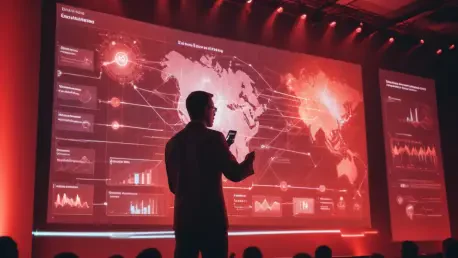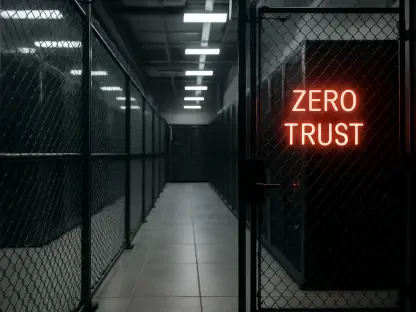Ericsson has introduced a groundbreaking clientless Zero Trust Network Access (ZTNA) solution to bolster the security of connected Internet of Things (IoT) and Operational Technology (OT) assets. Leveraging Ericsson’s existing NetCloud Secure Access Service Edge (SASE) platform, this innovative approach combines robust security measures with unparalleled flexibility. The solution empowers organizations to enable secure access for third-party contractors, vendors, and internal Bring Your Own Device (BYOD) users to sensitive systems and resources, addressing the increasing security risks associated with connected IoT and OT devices.
The Growing Importance of IoT/OT Security
Challenges of Securing Connected Assets
The proliferation of connected IoT and OT devices has made security a paramount concern for organizations. The increasing connectivity of these devices poses significant risks, especially given the prevalence of third-party cyber incidents. A recent study by KPMG indicates that 73% of organizations have experienced major disruptions linked to such incidents over the past three years. The inherent challenges of securing diverse and often unmanaged devices highlight the need for more advanced security solutions. Traditional methods, such as Virtual Private Networks (VPNs), often fall short due to their inability to provide granular access control and their complexity in implementation.
Organizations face the dual challenge of ensuring comprehensive security while maintaining the flexibility and efficiency of their connected assets. As IoT and OT environments become increasingly complex, the potential for cyber threats grows, necessitating more sophisticated security solutions. Ericsson’s clientless ZTNA solution addresses these challenges by offering a more secure and flexible access management approach. This is crucial for environments where third-party suppliers and contractors frequently manage and maintain operational assets, as it provides a means to mitigate risks associated with external access to sensitive systems.
Addressing Third-Party Risks
Ericsson’s clientless ZTNA solution is designed specifically to mitigate the risks posed by third-party access. This innovative solution leverages multiple layers of security to ensure that only authorized individuals can access sensitive assets. By implementing stringent access controls and utilizing advanced isolation technology, Ericsson’s NetCloud SASE platform ensures that application sessions are activated within isolated cloud containers. This approach effectively “air-gaps” sensitive systems, preventing malware from spreading from potentially compromised devices.
The clientless nature of Ericsson’s ZTNA solution is a significant advantage for organizations managing a diverse array of devices. This feature eliminates the need for deploying VPN clients on numerous third-party devices, which can be both time-consuming and challenging to manage. Instead, contractors and BYOD users can securely connect through a simple, secure URL, streamlining the access process while maintaining robust security measures. This approach not only enhances security but also simplifies the management process for IT teams, allowing them to focus on other critical tasks.
Core Features of Ericsson’s Solution
Embedded Isolation Technology
One of the standout features of Ericsson’s clientless ZTNA solution is its use of embedded isolation technology. Unlike other clientless solutions that rely solely on access controls, Ericsson’s NetCloud SASE platform goes a step further by activating application sessions within isolated cloud containers. This method creates a secure environment that effectively “air-gaps” sensitive corporate systems and operational networks from potentially compromised devices. By isolating these sessions, the solution prevents the spread of malware and other cyber threats into vulnerable OT environments, ensuring the integrity and security of critical assets.
The embedded isolation technology employed by Ericsson’s ZTNA solution addresses a significant gap in traditional clientless access management solutions. While many solutions rely on access controls to restrict user permissions, Ericsson’s approach provides an additional layer of security through isolation. This ensures that even if a device is compromised, the malware cannot spread to other systems within the network. This level of protection is particularly important in scenarios where third-party contractors and BYOD users are accessing sensitive systems, as it mitigates the risk of cyber threats originating from external sources.
Clientless Secure Access
The clientless secure access feature of Ericsson’s ZTNA solution is a game-changer for organizations, simplifying the process of granting secure access to contractors and BYOD users. By enabling secure connections through a simple, secure URL, the solution eliminates the need for deploying VPN clients or other software on numerous third-party devices. This not only streamlines the access process but also reduces the burden on IT teams, making it easier to manage access across a diverse array of devices. Additionally, the clientless nature of the solution ensures that organizations can maintain robust security measures without compromising on flexibility. This is particularly beneficial in dynamic environments where the types of devices accessing the network can vary widely.
The importance of clientless secure access cannot be overstated, especially in the context of IoT and OT environments. Traditional VPN solutions often require complex configurations and can be difficult to implement, particularly when dealing with a large number of devices. Ericsson’s clientless ZTNA solution addresses these challenges by providing a straightforward, policy-based approach to access management. This ensures that users can connect securely without the need for cumbersome software deployments, making it an ideal solution for organizations looking to enhance their security posture while maintaining operational efficiency.
Granular Access Control and Continuous Risk Assessment
Access Permissions Based on Least Privilege
Ericsson’s ZTNA solution enforces granular access permissions based on detailed policies, ensuring that users have the least privilege necessary for their tasks. This principle of least privilege minimizes the potential for unauthorized access and reduces the risk of security breaches. The access controls implemented by Ericsson’s solution consider various factors, including user roles, device types, and the specific assets being accessed. By tailoring access permissions to the unique needs of each user, the solution ensures that only authorized individuals can access sensitive systems and resources. This level of granularity is essential for maintaining a strong security posture in environments where multiple users and devices are accessing critical assets.
The principle of least privilege is a cornerstone of modern cybersecurity practices, and its implementation in Ericsson’s ZTNA solution highlights the company’s commitment to robust security measures. By restricting access to only what is necessary for each user’s tasks, the solution minimizes the attack surface and reduces the risk of insider threats. This approach is particularly important in IoT and OT environments, where a breach in one system can potentially compromise the entire network. By enforcing granular access controls, Ericsson’s ZTNA solution provides a higher level of security and peace of mind for organizations managing connected assets.
Real-Time Monitoring and Risk Mitigation
The continuous risk assessment capabilities of Ericsson’s ZTNA solution are another key feature that enhances its effectiveness in protecting critical infrastructure. Utilizing real-time analytics and integrated Intrusion Detection System/Intrusion Prevention System (IDS/IPS), the solution monitors user context and risk levels on an ongoing basis. This allows for instant access revocation if suspicious activity is detected, providing an additional layer of security for organizations. The ability to respond quickly to potential threats is crucial in environments where any delay in addressing a security issue can have significant consequences. Ericsson’s ZTNA solution ensures that organizations can effectively monitor and mitigate risks in real-time, enhancing their overall security posture.
The integration of real-time monitoring and risk mitigation capabilities into Ericsson’s ZTNA solution underscores the importance of proactive security measures in modern cybersecurity practices. By continuously analyzing user activity and risk levels, the solution can identify and respond to potential threats before they can cause significant harm. This approach is particularly valuable in IoT and OT environments, where the potential impact of a security breach can be substantial. Through the use of advanced analytics and IDS/IPS technology, Ericsson’s ZTNA solution provides organizations with the tools they need to stay ahead of emerging threats and protect their critical assets.
Zero-Trust Architecture and Management Integration
Eliminating Static IP Reliance
Ericsson’s zero-trust architecture is a forward-thinking approach that significantly enhances security by doing away with reliance on static public IP addresses. This architectural strategy conceals all internal IP addresses, including those of OT devices, which drastically limits the attack surface that cybercriminals can target. By defaulting to a deny-all posture, this approach ensures that access is only granted through explicitly defined policies and permissions. This level of security fundamentally changes how network access is managed, reducing vulnerabilities and preventing unauthorized lateral movement within the network if any access session is compromised.
Another critical aspect of this zero-trust architecture is micro-segmentation, which creates isolated segments within the network. This prevents an attacker who manages to breach one segment from moving effortlessly to other parts of the network. Micro-segmentation is especially important in IoT/OT environments where the variety and number of connected devices can present numerous potential points of entry for cyber threats. By limiting lateral movement, Ericsson’s ZTNA solution ensures that even if one part of the network is compromised, the rest remains secure. This layer of defense is essential for maintaining the integrity and security of interconnected systems and devices.
Unified Management Platform
Integration with NetCloud Manager allows Ericsson’s ZTNA solution to offer unified deployment, visibility, and policy enforcement across multiple networks and SASE features. This single-platform management capability simplifies the implementation of IT and IoT/OT access policies, making it easier for organizations to manage access control and security measures across diverse environments. The ability to oversee and enforce policies from a centralized platform streamlines the management process for IT teams, allowing them to maintain a consistent security posture while reducing administrative overhead. This level of integration ensures that organizations can efficiently manage their access control measures without compromising on security or flexibility.
The unified management platform provided by NetCloud Manager is a significant advantage for organizations looking to enhance their security measures while maintaining operational efficiency. By offering a centralized interface for managing access policies, the platform reduces complexity and simplifies the process of overseeing multiple networks and devices. This level of control is particularly valuable in IoT/OT environments, where the variety of devices and users accessing the network can make management challenging. With NetCloud Manager, organizations can effectively monitor and enforce security policies, ensuring that only authorized individuals have access to sensitive systems and resources.
Seamless Integration and Industry Perspectives
Compatibility with Existing Identity Providers
Ericsson’s ZTNA solution seamlessly integrates with existing enterprise Identity and Access Management (IAM) platforms, ensuring compatibility and preventing identity sprawl. This seamless integration simplifies the management of third-party credentials and enhances overall security by leveraging the security measures already in place within the organization. By utilizing existing IAM infrastructures, organizations can avoid the complexities and potential vulnerabilities associated with managing multiple identity systems. This compatibility ensures a unified approach to managing user identities and access permissions, enhancing the overall security posture of the organization.
The ability to integrate with existing IAM platforms is a significant advantage for organizations looking to adopt Ericsson’s ZTNA solution. This feature allows organizations to maintain a consistent approach to identity and access management, reducing the risk of security gaps and improving overall efficiency. By leveraging existing investments in IAM technology, organizations can streamline their access management processes while enhancing security measures. This compatibility is particularly valuable in environments where third-party contractors and BYOD users frequently access critical systems, as it provides a secure and efficient method for managing their credentials.
Expert Insights on VPN Limitations
Ericsson has unveiled a pioneering clientless Zero Trust Network Access (ZTNA) solution designed to enhance the security of interconnected Internet of Things (IoT) and Operational Technology (OT) assets. By leveraging its established NetCloud Secure Access Service Edge (SASE) platform, Ericsson’s innovative approach merges strong security protocols with unmatched flexibility. This advanced solution allows organizations to provide secure access for third-party contractors, vendors, and internal Bring Your Own Device (BYOD) users to critical systems and resources. It addresses the mounting security concerns linked to the growing number of connected IoT and OT devices. This advancement not only strengthens the defense mechanisms against potential cyber threats but also ensures seamless integration and management of diverse devices within an organization. Ericsson’s solution marks a significant step forward in securing the digital infrastructure crucial for modern operations, reflecting the evolving landscape of connectivity and cybersecurity.









